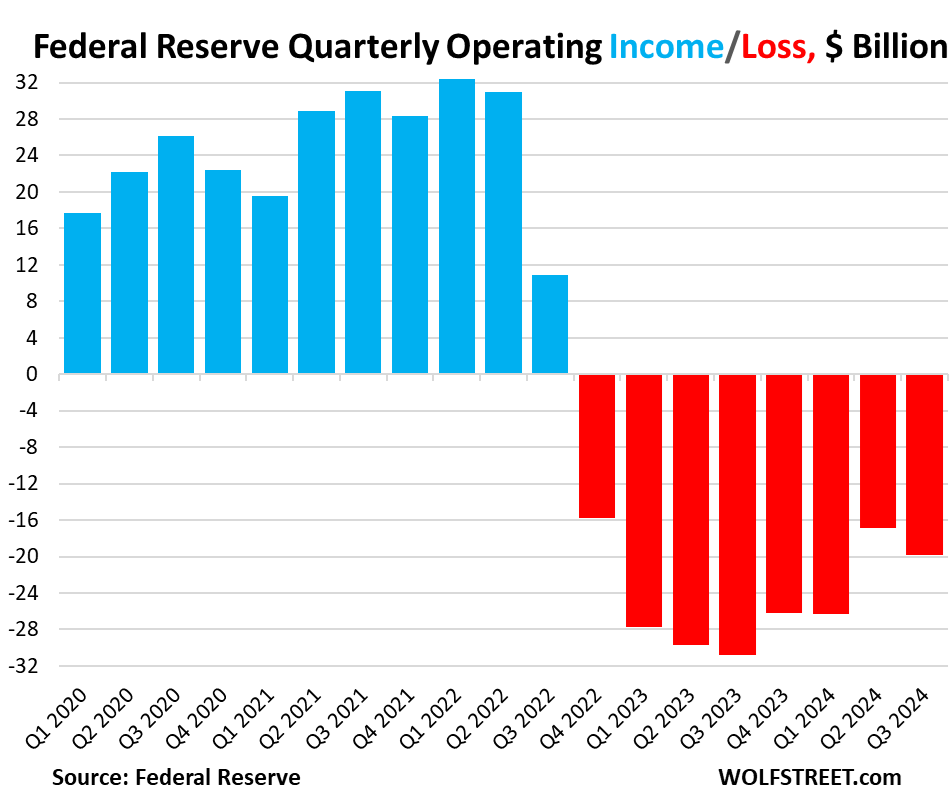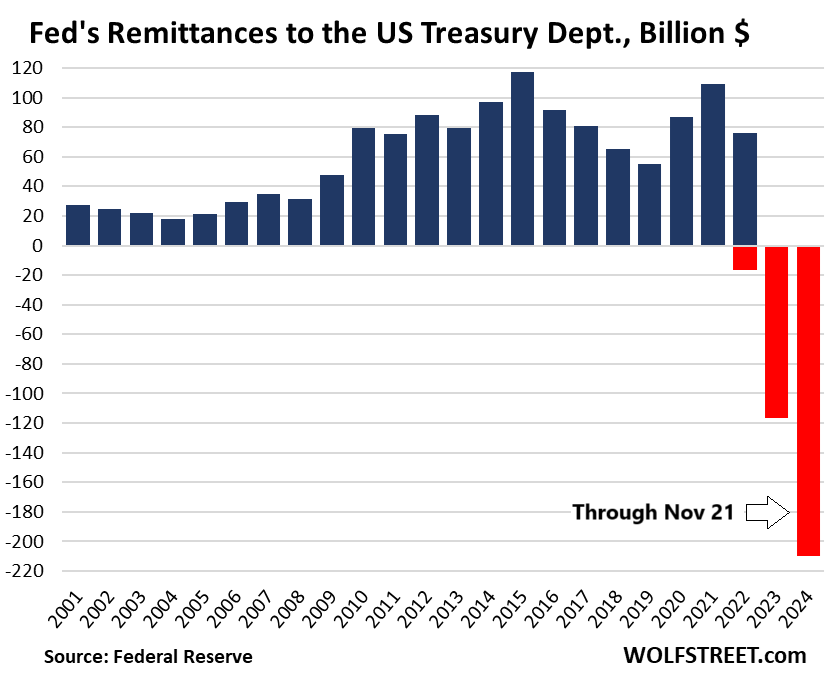[[{“value”:”
By Wolf Richter for WOLF STREET.
The Fed released its financial report for the third quarter on Friday afternoon. The two items we pay attention to in the era of the money-losing Fed are its operating losses and its “unrealized” losses.
Operating losses.
The Fed incurred $19.9 billion in operating losses in the quarter, down from $30.8 billion in Q3 a year ago, but up a little sequentially from Q2. Those losses are largely the difference between the interest income it earns on its huge but shrinking portfolio of Treasury securities and MBS, and the interest it pays to banks and money market funds on the shrinking amounts of cash they keep at the Fed.
The expenses of operating the Federal Reserve System – the Board of Governors of the Federal Reserve and the 12 Regional Federal Reserve Banks – are also included.

When the Fed started hiking its policy rates in early 2022, the interest rates it paid to banks (Interest on Reserve Balances, IORB) and the interest it paid money market funds (overnight reverse repos, ON RRPs) rose in tandem because they’re two of the Fed’s five policy rates. And so the interest expense shot up with higher rates, even as the combined balances began to decline due to QT.
But the interest income was capped as the Fed held an $8-plus trillion portfolio of longer-term securities whose interest rates didn’t go up. And then, as QT reduced those holdings, interest income from them also declined. As of the last balance sheet on Thursday, the Fed’s QT has reduced its total assets by $2 trillion, to $6.92 trillion.
So the interest income was capped and then started declining under QT, but the interest expense shot up with the higher policy rates, and by September 2022, the Fed started losing money.
On a quarterly basis, Q4 2022 was the first quarter when it was in the red. Losses worsened as the Fed hiked. Then as QT reduced liquidity in the financial system, the combined balance of reserves and ON RRPs began to decline, and the interest expense began to decline, and a year ago, the losses began to decline for the first time.
For the first three quarters of 2024 (YTD), the Fed’s operating loss declined to $63.1 billion, from $88.1 billion in the same period last year.
| Federal Reserve System, quarterly, in billion $ | |||||
| Q3 2024 | Q2 2024 | YTD 2024 | YTD 2023 | YTD Change | |
| Total Interest income | 38.0 | 44.7 | 121.5 | 132.7 | -11.2 |
| Interest Expense | |||||
| ON RRPs | 10.2 | 10.9 | 33.1 | 86.6 | -53.4 |
| Reserves | 46.9 | 48.3 | 145.7 | 128.0 | 17.7 |
| Total Interest Expense | 57.2 | 59.1 | 178.8 | 214.5 | -35.7 |
| Other income | 1.6 | 0.0 | 1.3 | 0.2 | 1.0 |
| Operating expenses | 2.3 | 2.4 | 7.1 | 6.6 | 0.5 |
| Net operating loss | -19.9 | -16.9 | -63.1 | -88.1 | -24.9 |
For the full year 2024, the operating loss will likely fall below $85 billion. For the year 2023, the Fed reported an operating loss of $114 billion. Depending on its future interest rate policies and the pace of QT, it will take several more years before the Fed stops generating operating losses.
“Unrealized losses.”
The Fed’s cumulative “unrealized losses” declined to $818 billion on September 30, from $1.075 trillion at the end of Q2, and down from $1.302 trillion at the peak, which was the end of Q3 2023. They declined mostly because longer-term yields continued to fall through Q3.
But that decline in yields ended in late September. Since then, yields on longer-term Treasuries and MBS have risen sharply. We have discussed this, and what it did to the yield curve, a lot, most recently here. So if this continues through December, the Fed’s cumulative unrealized losses might be back near the $1 trillion mark.
These cumulative unrealized losses are the difference between the securities’ amortized cost (which will be equal to face value by the time the security matures) and their market value at the end of the quarter:
- Securities, amortized cost: $6.88 trillion
- Market value on Sept. 30: $6.06 trillion
- Cumulative unrealized loss: $818 billion
The Fed bought most of these securities years ago when yields were far lower than now. As market yields rose over the past three years, market values declined. As securities get closer to their maturity date, the unrealized losses diminish and vanish entirely at maturity date when the holder gets paid face value.
In terms of MBS, they’re paid back mostly through a stream of passthrough principal payments as the underlying mortgages are paid off when the home is sold or refinanced, and as regular principal payments are made. When the pool of underlying mortgages shrinks enough, the MBS is “called,” the holder gets paid face value for the remaining balance, and the remaining mortgages are repacked into a new MBS. It’s unlikely that any of the MBS will still exist by their maturity date. The Fed will get its money back much sooner.
If the Fed never sells these securities, but just takes the cash when they mature or when passthrough principal payments are made, it will not have any actual (“realized”) losses. Securities in the Fed’s portfolio mature all the time, but many of them won’t mature for years, and some for decades.
Losses don’t matter to the Fed but matter to the Treasury Department.
Since the Fed creates its own money, it cannot become insolvent. So in essence, losses don’t matter to the Fed.
However, losses matter to the Treasury Department. The Fed has to remit nearly all of its operating income to the Treasury Department (like a 100% income tax). Those remittances stopped when the Fed stopped generating operating income. The losses pile up on the liability side of its balance sheet as a negative amount due the Treasury Department.
As of the last balance sheet on Thursday, that negative amount reached -$210 billion (last red column in the chart below), representing the total cumulative operating losses from September 2022 through Wednesday.
The Fed will continue to have declining operating losses for a while, and the cumulative negative amount will grow though more slowly (red columns). When the Fed finally generates operating income again, it will go against that negative amount and whittle it down over time, and remittances to the Treasury won’t restart until the negative balance has been reduced to zero, and then turns positive. This will take many years.
QE was a huge gravy train for taxpayers, generating remittances of $1.1 trillion from 2008 through Q3 2022. But then came the hangover.

Enjoy reading WOLF STREET and want to support it? You can donate. I appreciate it immensely. Click on the beer and iced-tea mug to find out how:
Would you like to be notified via email when WOLF STREET publishes a new article? Sign up here.
![]()
The post Operating Losses and “Unrealized” Losses of the Federal Reserve in Q3 2024 appeared first on Energy News Beat.
“}]] 

